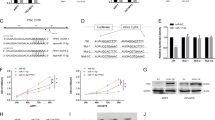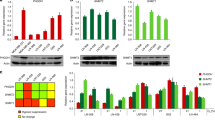Abstract
Anion exchanger-1 (AE1), an erythroid-specific membrane protein, mediates the Cl−/HCO−3 exchange across the plasma membrane and regulates intracellular pH. We have found that AE1 was unexpectedly expressed in gastric cancer cells and participated in the tumorigenesis of the cancer. Here, we focus on the induction of AE1 expression and its role in gastric carcinogenesis as well as in the differentiation of K562 cells. The results show that expression of AE1 is not related to genetic mutation or the mRNA level, but rather, that it is modulated by miR-24. miR-24 decreases the expression of AE1 through binding to the 3′UTR of AE1 mRNA. Transfection of an miR-24 into gastric cancer cells reduced the elevation of the AE1 protein, which resulted in return of AE1-sequestrated p16 to the nucleus, thereby inhibiting proliferation of the cells. Furthermore, the miR-24 inhibitor cooperated with hemin to induce the expression of AE1 in K562 cells and differentiation of the cells, which is consistent with results obtained from the cells cultured at pH 7.6 or from forced stable expression of AE1. These findings establish a novel regulation of miR-24-related AE1 expression in gastric carcinogenesis and erythropoiesis.
This is a preview of subscription content, access via your institution
Access options
Subscribe to this journal
Receive 50 print issues and online access
$259.00 per year
only $5.18 per issue
Buy this article
- Purchase on Springer Link
- Instant access to full article PDF
Prices may be subject to local taxes which are calculated during checkout






Similar content being viewed by others
References
Alper SL, Stuart-Tilley A, Simmons CF, Brown D, Drenckhahn D . (1994). The fodrin–ankyrin cytoskeleton of choroid plexus preferentially colocalizes with apical Na+K(+)-ATPase rather than with basolateral anion exchanger AE2. J Clin Invest 93: 1430–1438.
An X, Debnath G, Guo X, Liu S, Lux SE, Baines A et al. (2005). Identification and functional characterization of protein 4.1R and actin-binding sites in erythrocyte beta spectrin: regulation of the interactions by phosphatidylinositol-4,5-bisphosphate. Biochemistry 44: 10681–10688.
Durham JT, Herman IM . (2009). Inhibition of angiogenesis in vitro: a central role for beta-actin dependent cytoskeletal remodeling. Microvasc Res 77: 281–288.
Endo T, Ishibashi Y, Okana H, Fukumaki Y . (1994). Significance of pH on differentiation of human erythroid cell lines. Leuk Res 18: 49–54.
Friis-Hansen L . (2006). Achlorhydria is associated with gastric microbial overgrowth and development of cancer: lessons learned from the gastrin knockout mouse. Scand J Clin Lab Invest 66: 607–621.
Fu GH, Wang Y, Xi YH, Shen WW, Pan XY, Shen WZ et al. (2005). Direct interaction and cooperative role of tumor suppressor p16 with band 3 (AE1). FEBS Lett 579: 2105–2110.
Gabrielli BG, Sarcevic B, Sinnamon J, Walker G, Castellano M, Wang XQ et al. (1999). A cyclin D–Cdk4 activity required for G2 phase cell cycle progression is inhibited in ultraviolet radiation-induced G2 phase delay. J Biol Chem 274: 13961–13969.
Galluzzi L, Paiardini M, Lecomte MC, Magnani M . (2001). Identification of the main ubiquitination site in human erythroid alpha-spectrin. FEBS Lett 489: 254–258.
Gascard P, Mohandas N . (2000). New insights into functions of erythroid proteins in nonerythroid cells. Curr Opin Hematol 7: 123–129.
Georgantas III RW, Hildreth R, Morisot S, Alder J, Liu CG, Heimfeld S et al. (2007). CD34+ hematopoietic stem-progenitor cell microRNA expression and function: a circuit diagram of differentiation control. Proc Natl Acad Sci USA 104: 2750–2755.
Huo XF, Yu J, Peng H, Du ZW, Liu XL, Ma YN et al. (2006). Differential expression changes in K562 cells during the hemin-induced erythroid differentiation and the phorbol myristate acetate (PMA)-induced megakaryocytic differentiation. Mol Cell Biochem 292: 155–167.
Kudrycki KE, Newman PR, Shull GE . (1990). cDNA cloning and tissue distribution of mRNAs for two proteins that are related to the band 3 Cl−/HCO−3 exchanger. J Biol Chem 265: 462–471.
Kudrycki KE, Shull GE . (1989). Primary structure of the rat kidney band 3 anion exchange protein deduced from a cDNA. J Biol Chem 264: 8185–8192.
Lal A, Kim HH, Abdelmohsen K, Kuwano Y, Pullmann Jr R, Srikantan S et al. (2008). p16(INK4a) translation suppressed by miR-24. PLoS One 3: e1864.
Lal A, Pan Y, Navarro F, Dykxhoorn DM, Moreau L, Meire E et al. (2009). miR-24-mediated downregulation of H2AX suppresses DNA repair in terminally differentiated blood cells. Nat Struct Mol Biol 16: 492–498.
Lehnert ME, Lodish HF . (1988). Unequal synthesis and differential degradation of alpha and beta spectrin during murine erythroid differentiation. J Cell Biol 107: 413–426.
Lux SE, John KM, Kopito RR, Lodish HF . (1989). Cloning and characterization of band 3, the human erythrocyte anion-exchange protein (AE1). Proc Natl Acad Sci USA 86: 9089–9093.
McAdams TA, Miller WM, Papoutsakis ET . (1997). Variations in culture pH affect the cloning efficiency and differentiation of progenitor cells in ex vivo haemopoiesis. Br J Haematol 97: 889–895.
McAdams TA, Miller WM, Papoutsakis ET . (1998). pH is a potent modulator of erythroid differentiation. Br J Haematol 103: 317–325.
Merkerova M, Belickova M, Bruchova H . (2008). Differential expression of microRNAs in hematopoietic cell lineages. Eur J Haematol 81: 304–310.
Pavey S, Russell T, Gabrielli B . (2001). G2 phase cell cycle arrest in human skin following UV irradiation. Oncogene 20: 6103–6110.
Richards SM, Jaconi ME, Vassort G, Puceat M . (1999). A spliced variant of AE1 gene encodes a truncated form of band 3 in heart: the predominant anion exchanger in ventricular myocytes. J Cell Sci 112 (Part 10): 1519–1528.
Ruan K, Fang X, Ouyang G . (2009). MicroRNAs: novel regulators in the hallmarks of human cancer. Cancer Lett 285: 116–126.
Sahr KE, Taylor WM, Daniels BP, Rubin HL, Jarolim P . (1994). The structure and organization of the human erythroid anion exchanger (AE1) gene. Genomics 24: 491–501.
Schofield AE, Martin PG, Spillett D, Tanner MJ . (1994). The structure of the human red blood cell anion exchanger (EPB3, AE1, band 3) gene. Blood 84: 2000–2012.
Shapiro GI, Edwards CD, Rollins BJ . (2000). The physiology of p16(INK4A)-mediated G1 proliferative arrest. Cell Biochem Biophys 33: 189–197.
Shen WW, Wu J, Cai L, Liu BY, Gao Y, Chen GQ et al. (2007). Expression of anion exchanger 1 sequestrates p16 in the cytoplasm in gastric and colonic adenocarcinoma. Neoplasia 9: 812–819.
Showe LC, Ballantine M, Huebner K . (1987). Localization of the gene for the erythroid anion exchange protein, band 3 (EMPB3), to human chromosome 17. Genomics 1: 71–76.
Takakuwa Y . (2000). Protein 4.1, a multifunctional protein of the erythrocyte membrane skeleton: structure and functions in erythrocytes and nonerythroid cells. Int J Hematol 72: 298–309.
Walensky LD, Gascard P, Fields ME, Blackshaw S, Conboy JG, Mohandas N et al. (1998). The 13-kDa FK506 binding protein, FKBP13, interacts with a novel homologue of the erythrocyte membrane cytoskeletal protein 4.1. J Cell Biol 141: 143–153.
Wang CC, Moriyama R, Lombardo CR, Low PS . (1995). Partial characterization of the cytoplasmic domain of human kidney band 3. J Biol Chem 270: 17892–17897.
Wang JY, Lee YT, Chang PF, Chau LY . (2009). Hemin promotes proliferation and differentiation of endothelial progenitor cells via activation of AKT and ERK. J Cell Physiol 219: 617–625.
Wang Q, Huang Z, Xue H, Jin C, Ju XL, Han JD et al. (2008). MicroRNA miR-24 inhibits erythropoiesis by targeting activin type I receptor ALK4. Blood 111: 588–595.
Xu WQ, Song LJ, Liu Q, Zhao L, Zheng L, Yan ZW et al. (2009). Expression of anion exchanger 1 is associated with tumor progress in human gastric cancer. J Cancer Res Clin Oncol 135: 1323–1330.
Yang GH, Wang F, Yu J, Wang XS, Yuan JY, Zhang JW . (2009). MicroRNAs are involved in erythroid differentiation control. J Cell Biochem 107: 548–556.
Acknowledgements
This work was supported in part by the National Natural Science Foundation of China (NO30570697, NO30770960) and National High Technology Research and Development Program of China (863 Program) (NO2008AA02Z120).
Author information
Authors and Affiliations
Corresponding author
Rights and permissions
About this article
Cite this article
Wu, J., Zhang, YC., Suo, WH. et al. Induction of anion exchanger-1 translation and its opposite roles in the carcinogenesis of gastric cancer cells and differentiation of K562 cells. Oncogene 29, 1987–1996 (2010). https://doi.org/10.1038/onc.2009.481
Received:
Revised:
Accepted:
Published:
Issue Date:
DOI: https://doi.org/10.1038/onc.2009.481
Keywords
This article is cited by
-
Expression of AE1/p16 promoted degradation of AE2 in gastric cancer cells
BMC Cancer (2016)
-
Tumor suppressor miR-24 restrains gastric cancer progression by downregulating RegIV
Molecular Cancer (2014)
-
Cooperative and individualistic functions of the microRNAs in the miR-23a~27a~24-2 cluster and its implication in human diseases
Molecular Cancer (2010)
-
MicroRNA dysregulation in gastric cancer: a new player enters the game
Oncogene (2010)



